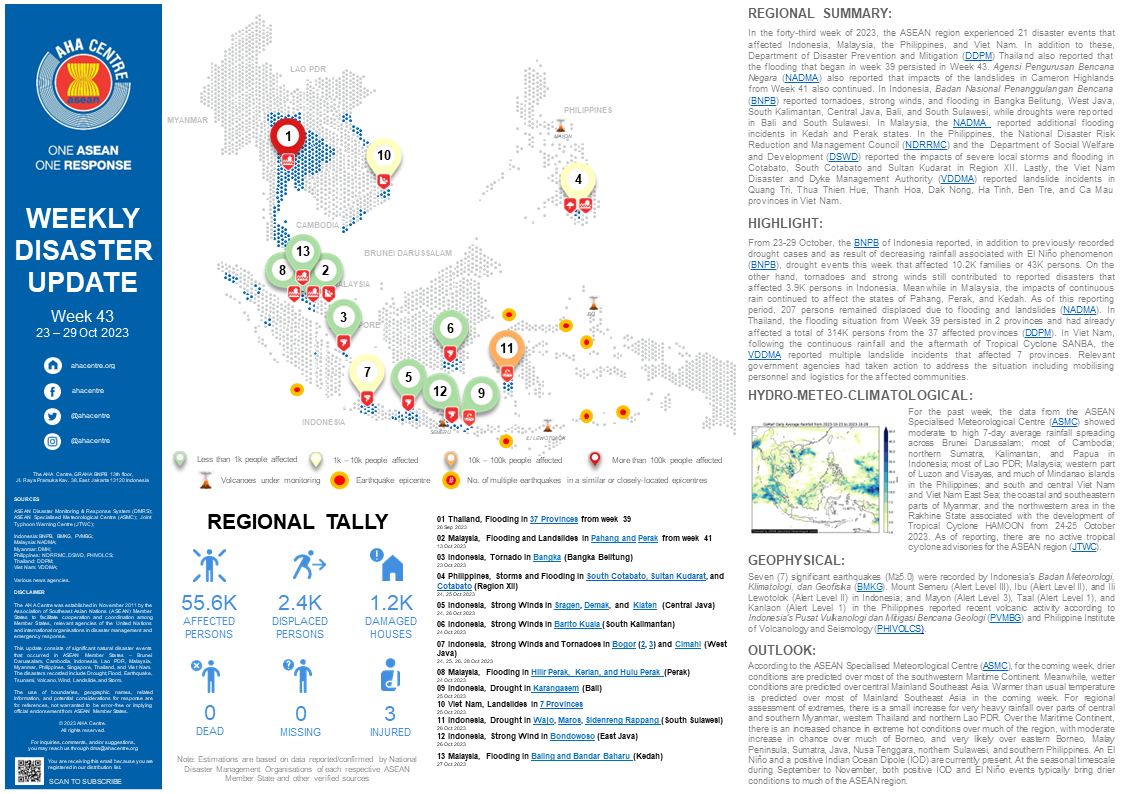
REGIONAL SUMMARY:
In the forty-third week of 2023, the ASEAN region experienced 21 disaster events that affected Indonesia, Malaysia, the Philippines, and Viet Nam. In addition to these, Department of Disaster Prevention and Mitigation (DDPM) Thailand also reported that the flooding that began in week 39 persisted in Week 43. Agensi Pengurusan Bencana Negara (NADMA) also reported that impacts of the landslides in Cameron Highlands from Week 41 also continued. In Indonesia, Badan Nasional Penanggulangan Bencana (BNPB) reported tornadoes, strong winds, and flooding in Bangka Belitung, West Java, South Kalimantan, Central Java, Bali, and South Sulawesi, while droughts were reported in Bali and South Sulawesi. In Malaysia, the NADMA reported additional flooding incidents in Kedah and Perak states. In the Philippines, the National Disaster Risk Reduction and Management Council (NDRRMC) and the Department of Social Welfare and Development (DSWD) reported the impacts of severe local storms and flooding in Cotabato, South Cotabato and Sultan Kudarat in Region XII. Lastly, the Viet Nam Disaster and Dyke Management Authority (VDDMA) reported landslide incidents in Quang Tri, Thua Thien Hue, Thanh Hoa, Dak Nong, Ha Tinh, Ben Tre, and Ca Mau provinces in Viet Nam.
HIGHLIGHT:
From 23-29 October, the BNPB of Indonesia reported, in addition to previously recorded drought cases and as result of decreasing rainfall associated with El Niño phenomenon (BNPB), drought events this week that affected 10.2K families or 43K persons. On the other hand, tornadoes and strong winds still contributed to reported disasters that affected 3.9K persons in Indonesia. Meanwhile in Malaysia, the impacts of continuous rain continued to affect the states of Pahang, Perak, and Kedah. As of this reporting period, 207 persons remained displaced due to flooding and landslides (NADMA). In Thailand, the flooding situation from Week 39 persisted in 2 provinces and had already affected a total of 314K persons from the 37 affected provinces (DDPM). In Viet Nam, following the continuous rainfall and the aftermath of Tropical Cyclone SANBA, the VDDMA reported multiple landslide incidents that affected 7 provinces. Relevant government agencies had taken action to address the situation including mobilising personnel and logistics for the affected communities.
HYDRO-METEO-CLIMATOLOGICAL:
For the past week, the data from the ASEAN Specialised Meteorological Centre (ASMC) showed moderate to high 7-day average rainfall spreading across Brunei Darussalam; most of Cambodia; northern Sumatra, Kalimantan, and Papua in Indonesia; most of Lao PDR; Malaysia; western part of Luzon and Visayas, and much of Mindanao islands in the Philippines; and south and central Viet Nam and Viet Nam East Sea; the coastal and southeastern parts of Myanmar, and the northwestern area in the Rakhine State associated with the development of Tropical Cyclone HAMOON from 24-25 October 2023. As of reporting, there are no active tropical cyclone advisories for the ASEAN region (JTWC).
GEOPHYSICAL:
Seven (7) significant earthquakes (M>5.0) were recorded by Indonesia’s Badan Meteorologi, Klimatologi, dan Geofisika (BMKG). Mount Semeru (Alert Level III), Ibu (Alert Level II), and Ili Lewotolok (Alert Level II) in Indonesia; and Mayon (Alert Level 3), Taal (Alert Level 1), and Kanlaon (Alert Level 1) in the Philippines reported recent volcanic activity according to Indonesia’s Pusat Vulkanologi dan Mitigasi Bencana Geologi (PVMBG) and Philippine Institute of Volcanology and Seismology (PHIVOLCS).
OUTLOOK:
According to the ASEAN Specialised Meteorological Centre (ASMC), for the coming week, drier conditions are predicted over most of the southwestern Maritime Continent. Meanwhile, wetter conditions are predicted over central Mainland Southeast Asia. Warmer than usual temperature is predicted over most of Mainland Southeast Asia in the coming week. For regional assessment of extremes, there is a small increase for very heavy rainfall over parts of central and southern Myanmar, western Thailand and northern Lao PDR. Over the Maritime Continent, there is an increased chance in extreme hot conditions over much of the region, with moderate increase in chance over much of Borneo, and very likely over eastern Borneo, Malay Peninsula, Sumatra, Java, Nusa Tenggara, northern Sulawesi, and southern Philippines. An El Niño and a positive Indian Ocean Dipole (IOD) are currently present. At the seasonal timescale during September to November, both positive IOD and El Niño events typically bring drier conditions to much of the ASEAN region.
Sources:
ASEAN Disaster Monitoring & Response System (DMRS); ASEAN Specialised Meteorological Centre (ASMC); Joint Typhoon Warning Centre (JTWC);
Indonesia: BNPB, BMKG, PVMBG;
Malaysia: NADMA;
Myanmar: DMH;
Philippines: NDRRMC, DSWD, PHIVOLCS;
Thailand: DDPM;
Viet Nam: VDDMA;
Various news agencies.







